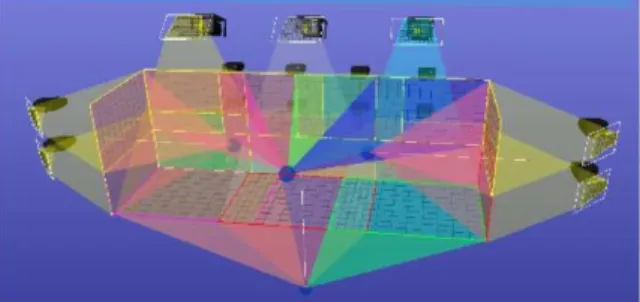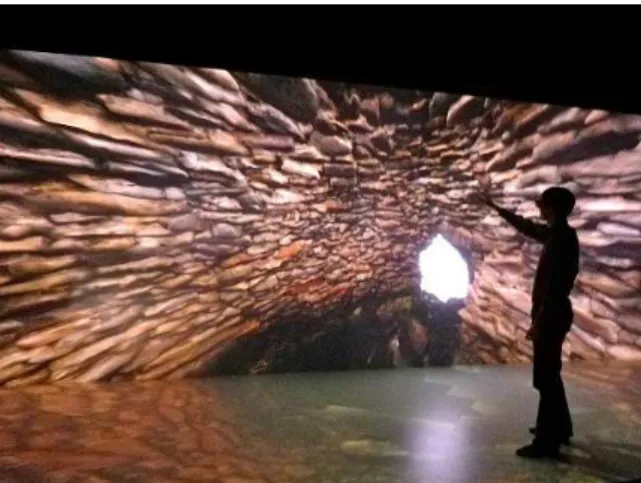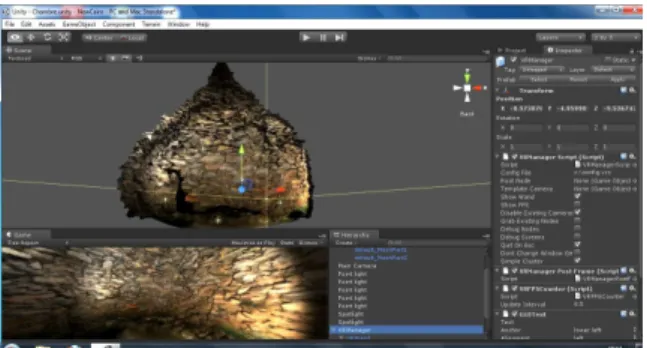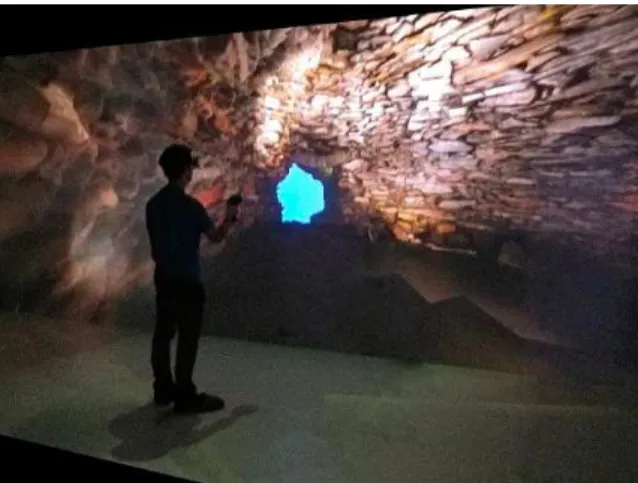HAL Id: hal-00748894
https://hal.archives-ouvertes.fr/hal-00748894
Submitted on 6 Nov 2012
HAL is a multi-disciplinary open access
archive for the deposit and dissemination of
sci-entific research documents, whether they are
pub-lished or not. The documents may come from
teaching and research institutions in France or
L’archive ouverte pluridisciplinaire HAL, est
destinée au dépôt et à la diffusion de documents
scientifiques de niveau recherche, publiés ou non,
émanant des établissements d’enseignement et de
recherche français ou étrangers, des laboratoires
Large-scale immersive reconstitution of a Neolithic
corbel dome
Ronan Gaugne, Jean-Baptiste Barreau, Florian Cousseau, Valérie Gouranton
To cite this version:
Ronan Gaugne, Jean-Baptiste Barreau, Florian Cousseau, Valérie Gouranton. Large-scale immersive
reconstitution of a Neolithic corbel dome. International Symposium on Virtual Reality, Archaeology
and Cultural Heritage, Nov 2012, Brighton, United Kingdom. pp 1-8. �hal-00748894�
The 13th International Symposium on Virtual Reality, Archaeology and Cultural Heritage VAST (2012) D. Arnold, J. Kaminski, F. Niccolucci, and A. Stork (Editors)
Large-scale immersive reconstitution
of a Neolithic corbel dome
Ronan Gaugne1,4, Jean-Baptiste Barreau2,5, Florian Cousseau1,5and Valérie Gouranton3,4
1University Rennes 12CNRS3INSA Rennes4IRISA/Inria Rennes5CReAAH
Abstract
We propose a workflow of tools and procedures to reconstruct an existing archaeological site as a virtual 3D reconstitution in a large scale immersive system. This interdisciplinary endeavor, gathering archaeologists and virtual reality computer scientists, is the first step of a joint research project with three objectives: (i) propose a common workflow to reconstruct archaeological sites as 3D models in fully immersive systems, (ii) provide archaeologists with tools and interaction metaphors to exploit immersive reconstitutions, and (iii) develop the use and access of immersive systems to archaeologists.
In this context, we present results from the immersive reconstitution of Carn’s monument central chamber, in Finistère, France, a site currently studied by the Creaah archaeology laboratory. The results rely on a detailed workflow we propose, which uses efficient solutions to enable archaeologists to work with immersive systems. In particular, we proposed a procedure to model the central chamber of the Carn monument, and compare several softwares to deploy it in an imersive structure. We then proposed two immersive implementations of the central chamber, with simple interaction tools, and finally describe the European project Visionair which provides access to high level visualization facilities.
Categories and Subject Descriptors(according to ACM CCS): [Computer Graphics]: I.3.7—Virtual reality [Com-puter Graphics]: I.3.6—Methodology and Techniques
1. Introduction
Virtual reality (VR) applications for archaeology mostly re-main limited to mono-screen visualization devices such as PC monitors or powerwall projections. Multi-display envi-ronments such as workbenchs, head-mounted displays, and CAVE-like installations are rarely used, partly because of the technical complexity to implement virtual universes and develop applications on such devices, but also because of the cost of these systems. However, such environments offer the user a very strong feeling of presence. Presence refers to the sense of “being-there”, inside the simulated environ-ment [LD97]. In addition, a significant benefit is the possi-bility of working in scale-one reconstitutions of existing or ruined sites.
Practical considerations have been leading archaeologists from the laboratory of archaeology and archaeosciences to virtual reality (VR) technologies: archaeological monu-ments are complex, sometimes unsafe, present issues in ac-cessibility and conservation, or are simply too large to
ex-plore. As a consequence, a number of studies in archaeology are physically impossible to conduct.
The work presented in this paper aims at assisting archae-ologists in their tasks using VR techniques. The contribu-tion we propose is to detail the steps and tools of a simple, complete and efficient workflow for reconstructing an exist-ing archaeological site into a virtual immersive reconstitu-tion. This represents the first step of an emerging collabora-tion between computer scientists and archaeologists, and has been organized in the following way:
• archaeologists performed a photographic scan of the cen-tral chamber of the Carn monument, see Figure 1, and produced a textured mesh model;
• computer scientists implemented two different VR appli-cations using this model, and deployed them using a large immersive system;
• archaeologists experienced the immersion in the virtual reconstitution to evaluate its usefullness and relevance for their research works.
dedi-R. Gaugne & J. B. Barreau & F. Cousseau & V. Gouranton / Large-scale immersive reconstitution of a cairn central chamber
Figure 1: The existing Carn monument.
cated to research projects on virtual reality. Its size and fea-tures enables fully immersive experiences; the platform is open to multi-disciplinary external research projects through the European research framework Visionair.
2. Related works
In the archaeological community, the need for 3D resti-tutions of structures or environments has dramatically in-creased. Beyond an obvious interest in terms of cultural her-itage valuation towards local visitors [NK11] or more gen-erally internet users [FF11], 3D restitutions allow to better understand their purposes and thus the societies that have oc-cupied them, and especially when restitutions are integrated into interactive virtual environments [SKC11] [SD11].
There has recently been a great deal of effort to use virtual reality to restitute archaeological and historical heritage to a large public through various media such as web [PCC∗08]
[DBG∗10], second life environments [Mor09], or museum
exhibitions [ZGS∗10] [BAG∗11].
In a similar way, the design of virtual reality tools for ar-chaeologists has received a significant interest. As pointed out by Krasniewicz [Kra00], virtual reality is not used to restitute knowledge here, but to acquire new knowledge. Our approach follows this principle: we provide archaeologists with an immersive virtual environment where they can make their own experience on the restituted material and infer new scientific conclusions.
In [CAL∗06], an immersive CAVE-like
struc-ture [CNSD∗92] combined with haptic devices and
3D sound has been used for pedagogic purposes in a museum exhibition, but also as a tool for research. The immersive application was implemented with the
XV framework [GCVR00], a high-level programming
interface designed to circumvent the issues in the de-velopent of CAVE-like environments. The Archave project [AVLJ01] [VALJ02] integrated also a CAVE-like structure and proposed tools for acheologists to study historical sites.
Another interesting work is presented in [FK10], where archaeologists collaborate remotely on shared virtual ob-jects through realistic avatars reconstructed from 3D cam-eras. Their virtual reality framework proposed a rich toolkit of interaction features, including navigation, measurement, lighting and dragging. However, due to the real-time 3D cap-ture and rendering of users, the visualisation was restricted to small image resolution (320x240 pixels) so as to ensure fluid rendering (25 FPS).
All of these contributions were based on models of sites manually build in 3D modelling tools. Another approach, when dealing with existing buildings or sites, is to use photo-modeling tools. This technique allows to automatically build textured 3D models from sets of photos of a site or object. A very interesting example is presented in [DDN∗06] with the
provision of an immersive virtual reality interface for Shaw-back Castle. The immersive environment consists of a large steroscopic projected wall, with infra-red tracking. The work focuses on semantic annotations of blocks to ensure consis-tency with a knowledge database associated to the model.
Immersive virtual reality tools, and especially those based on photogrammetry, appear as extremely usefull tools to as-sist archaeologists in their research.
3. Context of the work
The archaeological part of this work is performed in CReAAH laboratory whose policy is to develop the use of the 3D technologies in its research activity. The study of
construction of megalithic monuments issues are the heart of many archaeological projects of the laboratory. Among those, there are particular questions about pathways and points of view increasing the monumentality of megaliths constructed according to a given architecture. Determining the functional or aesthetic side of an architectural element also belongs to these questions. For example, is a singular profile of a cantilevered structure stronger than another or simply decorative? In addition, restitution and validation of hypothesis concerning collapsed parts thanks to landslides detailed analyzes is an essential tool to complete and under-stand the construction. From these complex issues, archae-ologists of the laboratory aspire to use an immersive system that, beyond a comfortable, safe and collaborative working, would allow:
• to view from any position in space a 3D model of the mon-ument and have a real size apprehension of all the differ-ent structures from all angles
• to mark and thus to count interesting and abundant ele-ments, which are not easily visible or reachable in reality • to simulate physically forces and structure crumblings.
The virtual reality part of this work is performed in IRISA/Inria laboratory whose policy is to promote multi-disciplanary projects, in particular with human and social sciences such as archaeology. The virtual reality team in charge of the immersive platform is involved in a Europen project leading to collaborate with external researchers on distinct domains such as sport, medicine, ergonomy, geogra-phy, or geology.
3.1. The monument of Carn
The monument of Carn is located in the western part of Brit-tany. It has been excavated during the 60´s by Pierre-Roland Giot and published in 1987 [Gio87]. The dating performed for this monument was the first radiocarbon dating in Bre-tagne, and results show that the monument belongs to the Vth millennium BC. Its location on an island has mostly pre-served it and the walls have a significant height. The method-ology has made progress since the 60´s, and more particu-larly the studies of these walls’ revetments.
The monument of Carn witnessed three phases of con-struction. First, a circular cairn with a corbel dome was built. This chamber is the subject of our 3D model. Then two parts have been added on each side of the cairn; the monument took a trapezoidal form and contained three chambers. At last, a large circular cairn (40m in diameter) came cover the precedent phases and hid them. Figure2shows the global map of the construction realized during the works of Pierre-Roland Giot. The central chamber with the corbel had a di-ameter of 3.50 m and a height of 3 meters when discovered, but now the dome has moved and the height lost one meter. A passage from outside opens in the chamber (see Figure3). It allowed the Neolithics to bring a body and deposit it in the chamber or to get one out.
Figure 2: Map of the Carn monument by Pierre-Roland
Giot [Gio87].
Figure 3: Inside view of the central chamber
The access to the site of Carn is difficult given that the monument is on an island and the passage to the chamber is closed by a door. The 3D model gives an unlimited ac-cess to the chamber. Furthermore, it is not possible to stand in the chamber which is very small and dangerous; the cor-belling is ready to fall. The immersive reconstitution allows
R. Gaugne & J. B. Barreau & F. Cousseau & V. Gouranton / Large-scale immersive reconstitution of a cairn central chamber
one or more people, through collaborative environments, to work directly in the virtual chamber. The interesting aspects of this chamber are the way it was built, the construction phases, and the esthetic of the chamber. All aspects can only be studied from inside the monument, and while a screen flattens the 3D model, the immersive reconstitution gives us a good tool to work with.
3.2. The immersive platform: Immersia
Figure 4: Immersia visualization structure
The immersive platform of IRISA/Inria is a large virtual-reality room dedicated to real-time, multimodal (vision, sound, haptic, BCI) and immersive interaction. It hosts ex-periments using interactive and collaborative VR applica-tions that have multiple local or remote users.
Images from Barco projectors are rendered on four glass screens, as presented in Figure4: a front one, two sides and a ground. Dimensions are 9.6 m wide, 2.9 m deep and 3.1 m high. Over 15 millions pixels are displayed. The visual reproduction system combines eight Barco Galaxy NW12 projectors and three Barco Galaxy 7+ projectors. The ART localization system, composed of 16 ARTtrack cameras, en-ables real objects to be tracked within the U-shape. Active stereoscopy is performed with a Volfony ActiveEyes Pro Ra-diofrequency system, synchronized with the projectors, and tracked by the ART cameras to synchonize the user’s point of view with the system’s point of view in real-time. Im-ages are recomputed as the user moves, together with high resolution rendering and homogeneous colouring, making them very realistic. Sound is rendered by a Yamaha pro-cessor, linked either to Genelec speakers with 10.2 format sound or Beyer Dynamic headsets with 5.1 virtual format sound, controlled by the user’s position. The computing and rendering system is composed of a cluster associating one computer per screen, and assigns each screen as a single window through the Nvidia SLI Mosaic mode. This immer-sive platform is a key node of the FP7 European Project Visionair which goal is to create a European infrastructure that should be a unique, visible and attractive entry towards high-level visualisation facilities for Virtual Reality, Scien-tific Visualisation, Ultra High Definition, Augmented Real-ity and Virtual Services. These facilities, distributed across
about twenty countries in Europe, are open and easily acces-sible to a wide set of research communities. Both physical access and virtual services are provided by the infrastruc-ture. Full access to visualization-dedicated software is of-fered through call for projects, while physical access to high level platforms will be partially accessible (about 20% of global usage) to other scientists, free of charge, based on the excellence of the project submitted.
4. Implementation work
We now present the two phases of the implementation work: 1. the photo-scan, and the generation of the textured model
both achieved by the archaeologists team;
2. the implementation of the immersive visit, achieved by the virtual reality team.
4.1. Digitization of the cairn central chamber
To reconstruct the central chamber, we follow the methodol-ogy employed for revetments in building archaeolmethodol-ogy. This methodology is conventionally applied to historical periods and not to pre-historical periods. One hundred photographs were taken inside the Cairn central chamber with a digital SLR camera Canon EOS 400D. Due to the narrowness of the chamber and to reduce the number of photos while ensur-ing a full scan, the archaeologist has consistently positioned himself against the wall, keeping a constant focal length dur-ing the shoot while drawdur-ing circular stripes from bottom to top. The darkness inherent in this type of structure also re-quired the use of a light source (a white led).
The photos were then treated using the High Performance Computer system of the "Climate and Land Use by Remote Sensing Laboratory", on which is installed Agisoft Photo-Scan (professional edition). The software is an automated image-based 3D modeling solution aimed at creating tex-tured 3D contents from arbitrary still images using the lat-est multi-view 3D reconstruction technologies. The interface of the software is presented in Figure5. The 4-socket rack server is a Dell Poweredge R815 offering AMD Opteron 6100 processors and 128 GB of RAM.
The PhotoScan application automatically executed the three main steps (alignment, polygonal mesh generation and texture mapping) from exactly 104 photos and provided the team with a textured 3D model of the chamber composed of 100 000 vertices and 200 000 faces in a few hours. Views of the resulting mesh are presented in Figure6. The model was generated in an OBJ format for easy exchanges with the virtual reality team.
4.2. Immersive implementation
The immersive implementation requires specific softwares able to handle:
Figure 5: User interface of the Photoscan tool (Agisoft) used
in the 3D reconstruction.
Figure 6: Internal view of the generated mesh.
• very large resolutions, with more than 15 millions pixel to display;
• tracking information from the ART system for the head-tracking of the user and the interaction using a flystick device;
• distribution and synchronization of the visual rendering on a cluster of PC;
• a quad-buffered stereoscopy system.
We chose two different software architectures, one based on open-source components, mainly Collaviz
[DDF∗10] and OpenSG www.opensg.org/ , and
one based on the commercial software Unity 3D
http://unity3d.com/ in conjunction with
Mid-dleVRwww.imin.fr/middlevr/.
The Collaviz/OpenSG implementation
Collaviz is an open-source software platform dedicated to remote collaboration for the design and visualization of sci-entific simulation-based applications. In the current imple-mentation, Collaviz uses Java3D for the 3D desktop views and jReality for the immersive view of the virtual environ-ment. Several modes are available for distributing the virtual objects of the virtual environment over TCP or HTTP pro-tocols. We have extended the system to handle the OpenSG rendering library for very efficient immersive views, in the
context of the VCoRE project [RCE∗12]. Remote
collab-orations have been experimented between two immersive CAVE-like infrastructures situated in two different European countries, in an application to analyze a model for under-ground propagation of seismic waves [FDGS12], as illus-trated in Figure7. We used a client-server mode in Collaviz,
Figure 7: Distant collaboration with the Collaviz platform.
with one visualization client per screen, and one central server on a distinct PC. An ART system was used for head tracking and interaction with the Flystick device. The ART system was interfaced with Collaviz using VRPN (Virtual Reality Peripherical Network) which is a standard device-independent and network-transparent system for accessing virtual reality peripherals. OpenSG was used as visualizer for all nodes. The resulting application is illustrated in Fig-ure8. The Flystick was used by the user to move the world and manipulate a clipping plane as illustrated in Figure9. This tool allows the user to dynamically hide a section of the universe behind a plane controlled by with the Flystick. This enables the user to focus on specific parts of the model. The manipulation of the clipping plane can be performed by several users in case a collaborative context.
Figure 8: Immersive view of the chamber with the Collaviz
R. Gaugne & J. B. Barreau & F. Cousseau & V. Gouranton / Large-scale immersive reconstitution of a cairn central chamber
Figure 9: Use of the clipping plan in Collaviz platform.
The Unity3D/MiddleVR implementation
Unity3D is a widely spread game engine, providing a user-friendly development interface (Figure 10). The interface integrates a modeling tool, the built-in NVIDIA PhysX physics engine, and a spatialized sound system. It supports three scripting languages: JavaScript, C#, and a dialect of Python named Boo. Unity3D does not natively support stere-oscopy, distributed execution and multi-display visualiza-tion. Two extensions are proposed to handle these features for virtual reality platforms: getReal3D commercialized by Mechdyne and MiddleVR commercialized by the company “I’m In VR”. As our immersive platform is an official bêta-test platform for MiddleVR, we chose this software. Mid-dleVR is a library handling all aspects of a virtual reality ap-plication: input devices, stereoscopy, multiple-display ren-dering, and clustering. It offers C++ and C# APIs (applica-tion programming interfaces), and a graphical user interface presented in Figure11to configure a virtual reality system. As for the Collaviz implementation, we used the ART sys-tem for head-tracking and interaction through with the Fly-stick through VRPN. The flyFly-stick was used by the user to move the world and manipulate a virtual torch in order to focus on specific parts of the universe (see Figure12).
5. Discussion on the results
5.1. Feedback on the implementations
The combination of Collaviz and OpenSG provides a very powerful software platform, with the possibility of remote real-time collaboration on the same virtual environment through different physical environments from smartphones to CAVE-like installations. The integration of the OBJ model was almost straightforward and only required an intermedi-ate manipulation to re-associintermedi-ate the texture to the mintermedi-aterial of the model. The clipping-plane tool was a reuse of an exist-ing implementation. Nevertheless, the different tasks of
con-Figure 10: Unity development interface.
Figure 11: MiddleVR configuration interface.
figuration, integration and deployment are not obvious and require a strong knowledge of the system and tools.
The combination of Unity and MiddleVR is extremely simple to use with the intuitive graphical interfaces. The OBJ model was integrated and visualized in the immersive plat-form in less than fifteen minutes. The manipulation to re-associate the texture to the material was directly done in the unity modeling interface. The torch was implemented in MiddleVR, based on a spot light defined in Unity3D. The deployment model of MiddleVR/Unity3D to manage distribution presents however some limitations: an indepen-dent instance of unity runs on each node of the cluster, and MiddleVR synchronizes the inputs and displays. When non-deterministic features such as physics or IA are used, the in-dependent instances of Unity may desynchronize. Last ver-sions of MiddleVR proposed a bêta-feature which enables the synchronization of Unity objects. This feature allows the programmer to precisely manage the level of synchroniza-tion of Unity objects, however increasing the complexity of the implementations. Another limitation concerns haptic de-vices which are not handled by MiddleVR. The
synchroniza-Figure 12: use of a virtual torch in Unity.
tion model does not enable efficient remote collaboration be-tween virtual environments.
The resulting implementation performances were mea-sured on the immersive platform with the following context of execution:
For the graphical rendering, we used two HP Z800, Intel Xeon 2 CPU quad-core E5630 2.53 GHz, Windows 7, 64 bits, one connected to the eight projectors of the front screen through two Nvidia quadroplex 2200, and one connected to the floor screen through one quadrople 2200. First PC had 12 GB RAM and 16 GB of graphics memory, and second one, 8GB RAM and 8GB of graphics memory. Resolution on the front screen was 6240 ×2016 pixels, and on the floor screen, 3502 × 1050 pixels, both in Nvidia SLI Mosaic mode.
For the Collaviz/OpenSG architecture, Collaviz core was running on a HP Z400, Intel Xeon CPU quad-core W3540 2.93 GHz, 6 GB RAM, Windows 7, 64 bits. All communica-tions between the computers used a Gigabit ethernet LAN.
We obtained the following performance display results : • Collaviz/OpenSG: 36 FPS
• MiddleVR/Unity3D: 34 FPS with the Unity native Fast quality, 22 FPS with Good quality, and 17 FPS with Fan-tastic quality.
The OpenSG implementation gives better results with a ren-dering quality equivalent to the Unity3D Fantastic renren-dering quality. The lower level of FPS for the MiddleVR/Unity3D implementation is due to the MiddleVR synchronization mechanism. However, the application remains still usable and fluent in the Fantastic mode.
5.2. Archaeologists evaluation of the system
Three archaeologists came into the immersive structure to evaluate the implementions. The first impression was the
good quality of the immersion sensation and rendering de-spite the model generation technique. The platform’s large size enables a complete and fast peripheral vision of the ar-chitectural structure. The natural navigation process allows to easily move to any position in the chamber and zoom on interesting parts such as paintings, colored stones or archi-tectural splits. These two features are difficult or even un-reachable in reality: a scaffolding would be necessary to ex-plore the whole monument.
The scale-one rendering is important because real size is fundamental for the building archaeologists. This simple use of the immersive application, visualization and navigation, is thus already scientifically relevant for problematics such as architectonic, color patterns and paintings.
The virtual torch should be greatly usefull to observe the effects of relief on engravings under different angles, in pari-etal art. The dynamic cuttin-plan tool easily allow to define sections and profiles while staying immersed in the model. The resulting portions of the model brings out unobvious splits and shapes in the building.
In a more general way, total freedom of exploration cou-pled with the ease of understanding of the site allowed by the structure, helped to immediatly created a real synergy between archaeologists. So that at the end of the immersion session, theories and ideas for new model exploration, cut-ting and analysis tools were discussed. These were readily seen as a base for future projects concerning on one side strictly archaeology and on the other side the link between archaeology and virtual reality.
6. Conclusions and future works
This work was considered as a first step in the collaboration between our two laboratories, but it already benefited both teams:
• on the archaeological point of view, we validated the pos-sibility and relevance of working in an immersive virtual reality (VR) structure;
• on the computer scientists point of view, we illustrated an important application field for our VR tools and facilities. The procedure we used is fully operational and provides rea-sonable solutions for archaeologists to work with realistic large-scale immersive reconstitutions of archaeological sites or monument. Further implementations will explore more evolved interaction tools, such as measurement tools, anno-tation of the model and dynamic lighting.
The next step in this work will be pursued with two other megaliths well preserved, Barnenez (Plouezoc´h, 29), Le Pe-tit Mont (Arzon, 56). Barnenez is a Neolithic monument lo-cated near Plouezoc’h, in northern Finistère. This megalithic construction is the oldest known megaliths and consists of two cairns and eleven rooms in which there are remarkable
R. Gaugne & J. B. Barreau & F. Cousseau & V. Gouranton / Large-scale immersive reconstitution of a cairn central chamber
megalithic art pieces. At the end of 2012, a complete digital-ization of the south tumulus of Barnenez is scheduled using a 3D scanner. The model will be integrated into the immer-sive platform.
With the 3D model coupled with topographic and bathy-metric data in different time periods, the use of the immer-sive platform, in collaboration with researchers located in another virtual reality platform in Spain, will help us to an-swer many archaeological questions such as:
• What were the pedestrian pathways and relevant points of view during a given time period depending on the level of water? The immersion will help us to answer efficiently. • How many colored stones (marking a commitment to
aes-thetics) were used and what are their coordinates in space? The ability to point and mark a stone will allow to make an accurate count which is impossible in the reality. • What were the construction steps and the many
differ-ent internal and earlier monumdiffer-ents? Pointing and drawing slices will allow us to find precious answers.
Acknowledgements
This work was supported in part by the European Project VISIONAIR and the VCORE Project. The authors want to thank Rémi Félix for his help on implementation.
References
[AVLJ01] ACEVEDO D., VOTE E., LAIDLAW D. H., JOUKOWSKY M. S.: Archaeological data visualization in VR: analysis of lamp finds at the great temple of petra, a case study. In IEEE Visualization (2001).2
[BAG∗11] BALEK., ABBOTTD., GOWIGATIR., PRITCHARD
D., CHAPMANP.: Linking Evidence with Heritage Visualiza-tion using a large Scale Collaborative Interface. In VAST: The 12th Int. Symp. on Virtual Reality, Archaeology and Intelligent Cultural Heritage(2011).2
[CAL∗06] CHRISTOUC., ANGUSC., LOSCOSC., DETTORIA.,
ROUSSOUM.: A versatile large-scale multimodal vr system for cultural heritage visualization. In VRST: ACM symp. on Virtual reality software and technology(2006).2
[CNSD∗92] CRUZ-NEIRAC., SANDIND. J., DEFANTIT. A.,
KENYONR. V., HARTJ. C.: The cave: audio visual experience automatic virtual environment. Commun. ACM 35, 6 (1992).2
[DBG∗10] DIAMANTI T., BLASCO P. D., GUIDAZZOLI A.,
LøSPEZM. S., TOFFALORIE.: ViSMan: an Open-Source Visu-alization Framework for Virtual Reconstructions and Data Man-agement in Archaeology. In VAST: The 11th Int. Symp. on Virtual Reality, Archaeology and Intelligent Cultural Heritage(2010).2
[DDF∗10] DUPONT F., DUVAL T., FLEURY C., FOREST J.,
GOURANTON V., LANDO P., LAURENT T., LAVOUÉ G., SCHMUTZ A.: Collaborative Scientific Visualization: The COLLAVIZ Framework. In JVRC (Joint Virtual Reality Conf. of EuroVR - EGVE - VEC)(2010).5
[DDN∗06] DRAPP., DURANDA., NEDIRM., SEINTURIERJ.,
PAPINIO., BOUCAULTF., CHAPMANP., VIANTW., VANNINI
G., NUCCIOTIM.: Towards a Photogrammetry and Virtual Real-ity Based Heritage Information System: A Case Study of Shaw-bak Castle in Jordan . In VAST: The 7th Int. Symp. on Virtual Reality, Archaeology and Intelligent Cultural Heritage(2006).2
[FDGS12] FLEURYC., DUVALT., GOURANTONV., STEEDA.: Evaluation of Remote Collaborative Manipulation for Scientific Data Analysis. In VRST: 18th Symp. on Virtual Reality Software and Technology(2012), ACM.5
[FF11] FANINI B., FERDANID.: A New Approach from 3D Modelling and Scanning of Archaeological Data to RealTime Online Exploration. In CAA: The 39th Conf. on Computer Appli-cations and Quantitative Methods in Archaeology(2011).2 [FK10] FORTE M., KURILLO G.: Cyberarchaeology:
Experi-menting with teleimmersive archaeology. In Virtual Systems and Multimedia(2010).2
[GCVR00] GAITATZES A., CHRISTOPOULOS D., VOULGARI
A., ROUSSOUM.: Hellenic cultural heritage through immersive virtual archaeology.2
[Gio87] GIOTP.-R.: Barnenez, Carn, Guennoc. Rennes, univer-site de Rennes 1, 1987. Travaux du Laboratoire "Anthropologie, Prehistoire, Protohistoire et Quaternaire armoricains".3
[Kra00] KRASNIEWICZL.: Immersive imaging technologies for
archeological research. In CAA: The 28th Conference on Com-puter Applications and Quantitative Methods in Archaeology (2000).2
[LD97] LOMBARDM., DITTONT.: At the Heart of It All: The Concept of Presence. Journal of Computer-mediated Communi-cation 3(1997).1
[Mor09] MORGANC. L.: (re)building catalhoyuk : Changing vir-tual reality in archaeology. Archaeologies, 1935-3987 5 (2009).
2
[NK11] NAOKI KONDO HIROYOSHI WATANABE S. S. E.A.: Bringing Regional Heritage Sites Into 3D Virtual Environments: Cost-Free Data Workflow and Multiple 3D Exhibition. In CAA: The 39th Conf. on Computer Applications and Quantitative Methods in Archaeology(2011).2
[PCC∗08] PESCARIN S., CALORI L., CAMPORESI C., IOIA
M. D., FORTE M., GALEAZZIF., IMBODEN S., MOROA., PALOMBINIA., VASSALLOV., VICOL.: Back to 2nd AD A VR on-line experience with Virtual Rome Project. In VAST: The 9th Int. Symp. on Virtual Reality, Archaeology, and Cultural Her-itage(2008).2
[RCE∗12] RAFFIN B., CARBONNIER H., ESNAULT J., LOM
-BARDOJ.-C., FELIXR., DUVALT., CHAUFFAUTA., DUMONT
G., GAUGNER., GOURANTONV., FAUREF., PIMETJ. A. R., HUOTS., JUNGY., BOCKHOLTU., BEHRJ., SCHWENKK., VOSSG.: The vcore project: First steps towards building a next-generation visual computing platform. In Proceeding of the As-sociation Fran caise de la Rálité Virtuelle(2012).5
[SD11] STUARTDUNNKIRKWOOLFORDL. B.E.A.: Motion in Place: a Case Study of Archaeological Reconstruction Using Motion Capture. In CAA: The 39th Conf. on Computer Applica-tions and Quantitative Methods in Archaeology(2011).2 [SKC11] SARAH KENDERDINEM. F., CAMPORESIC.:
Rhi-zome of Western Han: an Omnispatial Theatre for Archaeology. In CAA: The 39th Conf. on Computer Applications and Quanti-tative Methods in Archaeology(2011).2
[VALJ02] VOTEE., ACEVEDOD., LAIDLAWD., JOUKOWSKY
M.: Discovering petra: Archaeological analysis in vr. In IEEE Computer Graphics and Applications(2002).2
[ZGS∗10] ZABULIS X., GRAMMENOS D., SARMIS T., TZE
-VANIDIS K., ARGYROS A. A.: Exploration of Large-scale Museum Artifacts through Non-instrumented, Location-based, Multi-user Interaction. In VAST: The 11th Int. Symp. on Virtual Reality, Archaeology and Intelligent Cultural Heritage(2010).2
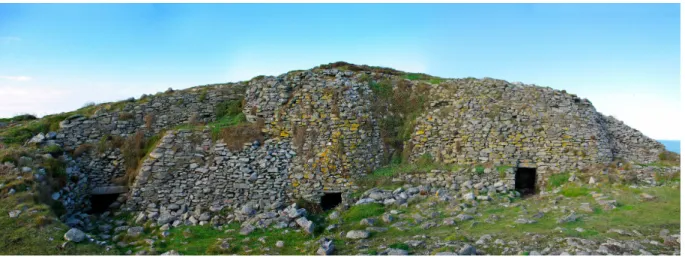
![Figure 2: Map of the Carn monument by Pierre-Roland Giot [Gio87].](https://thumb-eu.123doks.com/thumbv2/123doknet/11330955.283458/4.892.469.790.131.401/figure-map-carn-monument-pierre-roland-giot-gio.webp)
